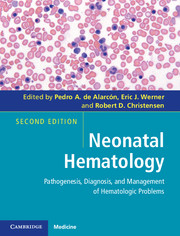Book contents
- Frontmatter
- Contents
- Contributors
- Foreword
- Preface
- 1 A historical review
- Section I Developmental hematology
- Section II Erythrocyte disorders
- Section III Platelet disorders
- Section IV Leukocyte disorders
- 13 Abnormal blood concentrations of eosinophils and neutrophils
- 14 Neutrophil function disorders
- Section V Immunologic disorders
- Section VI Hemostatic disorders
- Section VII Transfusional medicine
- Section VIII Miscellaneous
- Index
- Plate section
- References
14 - Neutrophil function disorders
from Section IV - Leukocyte disorders
Published online by Cambridge University Press: 05 February 2013
- Frontmatter
- Contents
- Contributors
- Foreword
- Preface
- 1 A historical review
- Section I Developmental hematology
- Section II Erythrocyte disorders
- Section III Platelet disorders
- Section IV Leukocyte disorders
- 13 Abnormal blood concentrations of eosinophils and neutrophils
- 14 Neutrophil function disorders
- Section V Immunologic disorders
- Section VI Hemostatic disorders
- Section VII Transfusional medicine
- Section VIII Miscellaneous
- Index
- Plate section
- References
Summary
Introduction
The phagocytes comprise a small group of hematopoietically-derived cells that play diverse roles in human host defense. The name, coined by Elie Metchnikoff over a century ago (1), refers to one of their most prominent specializations – the ability to ingest particulate targets. However, Metchnikoff’s “microphages” and “macrophages” do much more than simply ingest foreign materials. They perform multiple roles in inflammation and host defense, in both the innate and adaptive arms of immunity. The following section will address phagocytic cells in their host defense roles as they relate to innate immunity, using the polymorphonuclear leukocyte (PMN) and its functions in the human neonate as the major focus of discussion.
Neonatal phagocyte production
Hematopoiesis in the fetus is initiated in the yolk sac, with the formation of “blood islands” from primitive blood progenitor cells. By the second month of gestation, the fetal liver becomes the major site of blood cell production, which then extends to include the spleen by 5 months’ gestation. At about this same time, the earliest components of marrow-based blood production appear and continue to become more prominent over the subsequent months leading up to term, while splenic and hepatic hematopoiesis diminish. During this time, pluripotent hematopoietic stem cells are present in the circulation (2), presumably in transit from hepatic and splenic hematopoiesis sites to the marrow for subsequent blood cell production during extra-uterine life. Most of these progenitor cells disappear from the circulation over 3 days following birth (3). The proliferative potential of the cells in the circulation at the time of term birth is actually greater than that of adult bone marrow cells (4), based upon in vitro studies, suggesting that the neonate’s myeloid blood cell production capabilities should be normal. However, at the time of delivery and during the neonatal period, myeloid cell production and kinetics differ from those of older children and adults.
- Type
- Chapter
- Information
- Neonatal HematologyPathogenesis, Diagnosis, and Management of Hematologic Problems, pp. 231 - 254Publisher: Cambridge University PressPrint publication year: 2013



